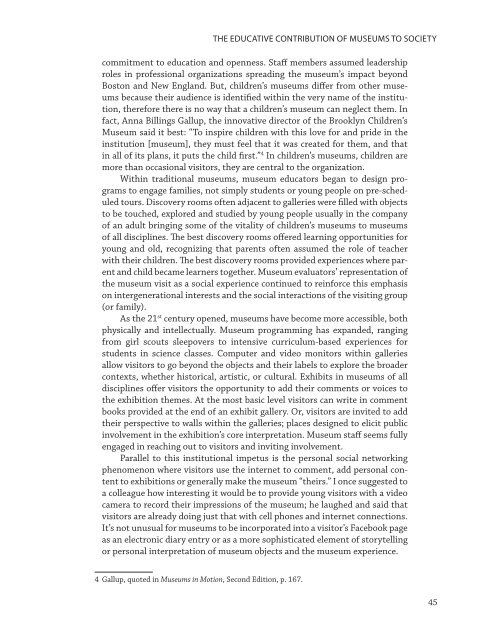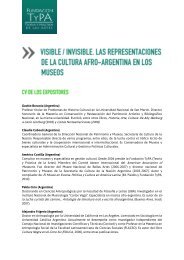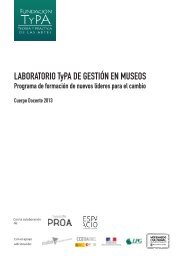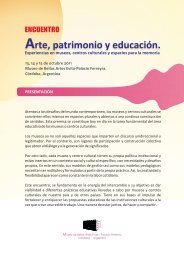La aportación educativa de Los museos a La ... - Fundación Typa
La aportación educativa de Los museos a La ... - Fundación Typa
La aportación educativa de Los museos a La ... - Fundación Typa
You also want an ePaper? Increase the reach of your titles
YUMPU automatically turns print PDFs into web optimized ePapers that Google loves.
the educative contribution of museums to society<br />
commitment to education and openness. Staff members assumed lea<strong>de</strong>rship<br />
roles in professional organizations spreading the museum’s impact beyond<br />
Boston and New England. But, children’s museums differ from other museums<br />
because their audience is i<strong>de</strong>ntified within the very name of the institution,<br />
therefore there is no way that a children’s museum can neglect them. In<br />
fact, Anna Billings Gallup, the innovative director of the Brooklyn Children’s<br />
Museum said it best: “To inspire children with this love for and pri<strong>de</strong> in the<br />
institution [museum], they must feel that it was created for them, and that<br />
in all of its plans, it puts the child first.” 4 In children’s museums, children are<br />
more than occasional visitors, they are central to the organization.<br />
Within traditional museums, museum educators began to <strong>de</strong>sign programs<br />
to engage families, not simply stu<strong>de</strong>nts or young people on pre-scheduled<br />
tours. Discovery rooms often adjacent to galleries were filled with objects<br />
to be touched, explored and studied by young people usually in the company<br />
of an adult bringing some of the vitality of children’s museums to museums<br />
of all disciplines. The best discovery rooms offered learning opportunities for<br />
young and old, recognizing that parents often assumed the role of teacher<br />
with their children. The best discovery rooms provi<strong>de</strong>d experiences where parent<br />
and child became learners together. Museum evaluators’ representation of<br />
the museum visit as a social experience continued to reinforce this emphasis<br />
on intergenerational interests and the social interactions of the visiting group<br />
(or family).<br />
As the 21 st century opened, museums have become more accessible, both<br />
physically and intellectually. Museum programming has expan<strong>de</strong>d, ranging<br />
from girl scouts sleepovers to intensive curriculum-based experiences for<br />
stu<strong>de</strong>nts in science classes. Computer and vi<strong>de</strong>o monitors within galleries<br />
allow visitors to go beyond the objects and their labels to explore the broa<strong>de</strong>r<br />
contexts, whether historical, artistic, or cultural. Exhibits in museums of all<br />
disciplines offer visitors the opportunity to add their comments or voices to<br />
the exhibition themes. At the most basic level visitors can write in comment<br />
books provi<strong>de</strong>d at the end of an exhibit gallery. Or, visitors are invited to add<br />
their perspective to walls within the galleries; places <strong>de</strong>signed to elicit public<br />
involvement in the exhibition’s core interpretation. Museum staff seems fully<br />
engaged in reaching out to visitors and inviting involvement.<br />
Parallel to this institutional impetus is the personal social networking<br />
phenomenon where visitors use the internet to comment, add personal content<br />
to exhibitions or generally make the museum “theirs.” I once suggested to<br />
a colleague how interesting it would be to provi<strong>de</strong> young visitors with a vi<strong>de</strong>o<br />
camera to record their impressions of the museum; he laughed and said that<br />
visitors are already doing just that with cell phones and internet connections.<br />
It’s not unusual for museums to be incorporated into a visitor’s Facebook page<br />
as an electronic diary entry or as a more sophisticated element of storytelling<br />
or personal interpretation of museum objects and the museum experience.<br />
4 Gallup, quoted in Museums in Motion, Second Edition, p. 167.<br />
45






